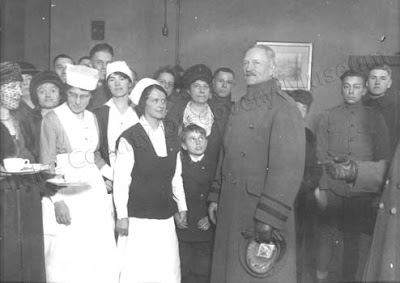During World War I (1914-1918), Fort Sheridan was at the forefront of mustering and training soldiers. Much of that training
focused on mastering trench warfare, since the frontline in Europe was
cluttered with the trenches of opposing armies.
As wounded soldiers returned from the war, the Fort
shifted its priority from training soldiers to caring for them.
Many of the
injuries treated at the Fort were caused by innovations new to warfare such as airplanes and poison gas. More than 30% of American casualties were from poisonous gases which ranged from
disabling chemicals (tear gas and severe mustard gas) to lethal agents (phosgene and chlorine). Gases blistered exposed flesh and caused rapid or, worse, gradual
asphyxiation. Those fortunate enough to
survive needed somewhere to convalesce.
The hospital at Fort Sheridan was built in 1893 and shown here circa 1930. Dunn Museum 92.24.1384 |
In
1918, the Post’s hospital expanded
its operations and became General Hospital No. 28. Later it was dedicated as Lovell General Hospital for General Joseph Lovell (1788-1836), Surgeon General of the U.S. Army from 1818-1836.
Associated Press article which appeared in The Dispatch, Moline, Illinois on October 18, 1918.
The hospital grew into a
multi-building complex, including the entire Tower complex. Temporary wooden structures were constructed on the Post’s parade grounds. This was the largest
military hospital in the United States to treat wounded and convalescent
soldiers.
View of Fort Sheridan looking northwest, showing the Tower and temporary
buildings for General Hospital No. 28 (later Lovell General Hospital) across the parade grounds.
Circa 1919. Dunn Museum 95.32.1
|
The "Trackless Train" at Fort Sheridan moved wounded between
hospital wards for treatment. Photo from the Chicago Tribune,
March 8, 1919. |
Even with the Fort Sheridan hospital and other facilities throughout the country, there were more casualties than the system could handle. In addition to treating veterans of the war, Fort Sheridan's hospital accepted civilians suffering from the Great Flu Epidemic of 1918.
In 1919, the Hostess House of the Young Women's Christian Association was built at Fort Sheridan using
salvaged material. General Pershing, commander of the American Expeditionary Forces on the
Western Front in World War I, visited Fort Sheridan and the Hostess House in December 1919.
The facility provided a library and tea room which served homemade meals to convalescing soldiers. Dunn Museum 95.32.24. |
Paul Steorp of Deerfield Township, Lake County, IL, wearing gas mask. Steorp served with the U.S. Army Ambulance Service. Dunn Museum 2003.0.16 |
The World War prompted an enormous expansion of the Army Medical Department. When the U.S. entered the war the department consisted of less than 1,000 personnel. By the time the peace treaty was signed in November 1918, it numbered over 350,000.
In 1920, the temporary structures of Lovell General Hospital
were dismantled and sold, and the parade field returned to an open state.
The memory of the horrors of WW I prompted changes in training soldiers for future conflicts, including mandatory gas mask training.
2nd U.S. Infantry training in tear gas at Fort Sheridan,
circa 1925. Dunn Museum 92.24.1015.
|
Soldiers entering a gas chamber built on the Fort's Lake Michigan
shoreline. Circa 1935. Dunn Museum 92.24.1761.
|
Overseas during wartime, military personnel, nurses and civilians were legally required to carry gas masks at all times. Members of the Womens' Army Corps trained in the use of gas masks in simulation chambers as part of their
coursework on chemical warfare and some studied gas identification in Officer Candidate School
Women's Army Corps members emerging from gas chamber training
at Fort Sheridan, 1964. Dunn Museum 92.24.1202
|
To this day, researchers work to increase protection for military personnel
against greater varieties of biological and chemical weapons.
The Bess Bower Dunn Museum's (formerly the Lake County Discovery Museum) Fort Sheridan Collection is digitized and hosted online at the Illinois Digital Archives.










